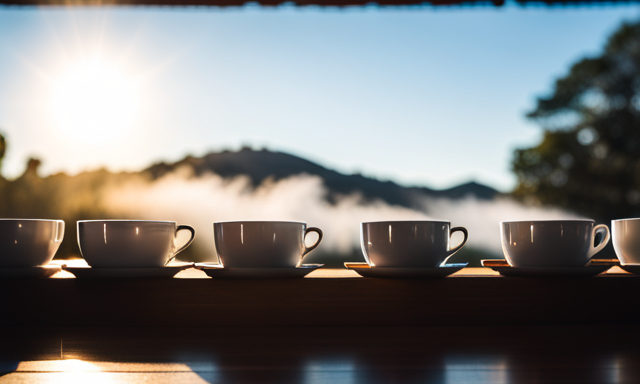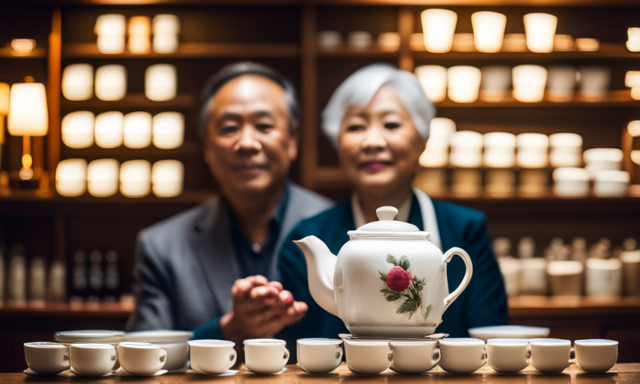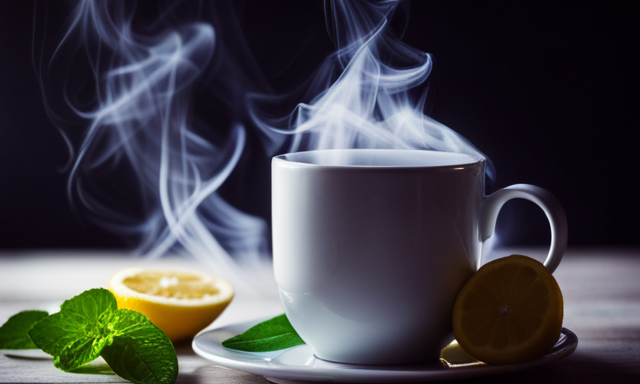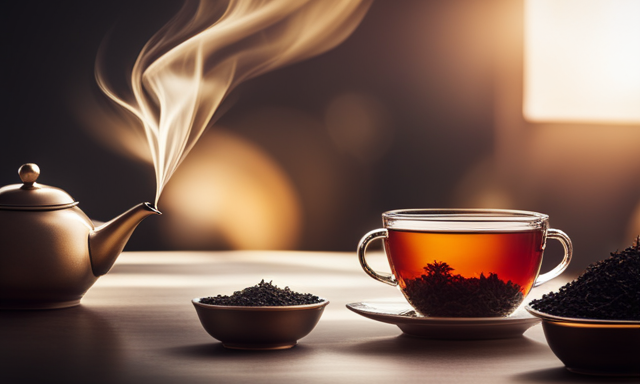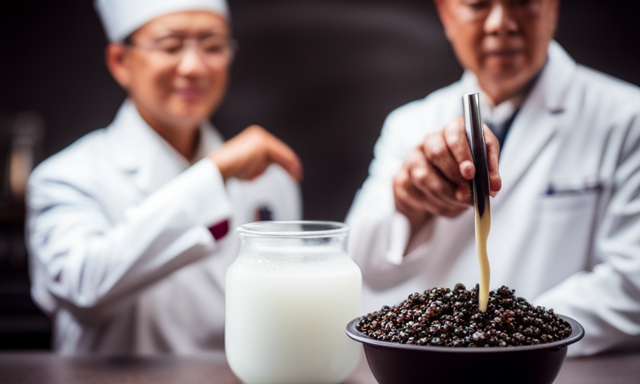Every morning, while enjoying a hot cup of oolong tea, I can feel its comforting warmth enveloping me, invigorating my senses and preparing me for the day ahead.
Oolong tea, with its unique flavor and countless health benefits, has become an essential part of my daily routine. But how many times should one indulge in this delicious beverage to truly reap its rewards?
In this article, we will delve into the science behind oolong tea, explore its recommended daily intake, and discover the best times of day to enjoy its goodness. Whether you are seeking to enhance your weight loss journey, boost your overall health, or improve your mental well-being, we will guide you in finding your perfect oolong tea routine.
So, grab your favorite mug and let’s embark on a flavorful and invigorating journey through the world of oolong tea.
Key Takeaways
- Oolong tea can aid in weight loss by boosting metabolism and promoting fat oxidation.
- Drinking oolong tea one to three times a day is recommended for optimal benefits.
- Oolong tea has antioxidant properties that protect against damage from free radicals and improve insulin sensitivity.
- Consuming oolong tea in moderation can support hydration, digestion, heart health, and mental well-being.
The Health Benefits of Oolong Tea
You’ll be delighted to know that oolong tea offers a multitude of health benefits for you to savor!
Research has shown that oolong tea can have a positive impact on heart health. Drinking oolong tea regularly has been associated with lower risk of heart disease and stroke. It contains antioxidants called polyphenols that help reduce inflammation and improve blood flow.
Additionally, oolong tea has been found to aid in digestion. It can help stimulate the production of digestive enzymes, which can improve nutrient absorption and alleviate digestive issues like bloating and constipation.
Understanding oolong tea is key to reaping its benefits. So, let’s dive into the details and learn more about this amazing tea!
Understanding Oolong Tea
Sipping oolong tea throughout the day is like dancing with a gentle breeze, a harmonious melody that awakens the senses. Oolong tea, also known as Wu long tea, is made from the leaves of the Camellia sinensis plant.
The time of harvest and processing methods greatly influence its flavor and aroma. Here are some key points to understand about oolong tea:
-
Time of harvest: Oolong tea is usually harvested in the spring or autumn, when the leaves are at their peak freshness and flavor.
-
Processing methods: Oolong tea is partially oxidized, which gives it a unique taste that falls between green and black tea.
-
Handcrafted: Oolong tea is often handpicked and handcrafted, ensuring the highest quality and attention to detail.
-
Varieties: There are various types of oolong tea, ranging from light and floral to dark and robust.
-
Health benefits: Oolong tea is believed to have numerous health benefits, including weight management and promoting heart health.
Understanding the time of harvest and processing methods of oolong tea sets the stage for understanding its recommended daily intake.
Recommended Daily Intake of Oolong Tea
When it comes to enjoying the benefits of oolong tea, moderation is key. The recommended daily intake of oolong tea varies depending on several factors, such as your overall health, caffeine sensitivity, and any existing medical conditions. It’s important to listen to your body’s response and adjust your consumption accordingly.
Moderation is Key
Finding the perfect balance is essential when it comes to enjoying the benefits of oolong tea. While oolong tea offers numerous health benefits, it’s important to consume it in moderation. Too much of a good thing can have negative effects.
When it comes to oolong tea, finding balance means avoiding excess. The recommended intake of oolong tea varies depending on factors such as age, overall health, and individual tolerance. However, a general guideline is to consume 2-3 cups per day. This amount allows you to experience the benefits of oolong tea without overdoing it.
Factors to consider when determining your optimal intake include any existing health conditions, sensitivity to caffeine, and any potential interactions with medications. By finding the right balance and considering these factors, you can maximize the benefits of oolong tea in your daily routine.
Factors to Consider
One important aspect to keep in mind is the various factors that should be considered when determining the optimal intake of oolong tea. Factors such as age, health condition, and personal preference can influence how much oolong tea one should drink in a day. For example, individuals with certain health conditions may need to limit their intake, while others may be able to consume more. Additionally, the caffeine content in oolong tea can affect how much is consumed, as caffeine sensitivity varies among individuals. It is important to note that oolong tea has been associated with numerous health benefits, including improved heart health and weight management. However, it is always recommended to consult with a healthcare professional to determine the appropriate amount of oolong tea for your specific needs. Listening to your body’s response can also provide valuable insights into whether you are consuming the right amount of oolong tea for you.
Listen to Your Body’s Response
Pay attention to how your body reacts when you consume oolong tea, as it can provide valuable insights into whether it’s the right choice for you. Listening to your body is essential in finding the right balance with oolong tea.
Some people may find that they feel energized and focused after drinking oolong tea, while others may experience jitters or digestive discomfort. By paying attention to these signals, you can determine how much oolong tea is appropriate for you.
Start by having one cup a day and observe how your body responds. If you feel good, you can gradually increase the amount. However, if you notice any negative effects, it may be best to reduce your intake.
Transitioning into the next section, let’s explore the optimal time of day to drink oolong tea.
Time of Day to Drink Oolong Tea
Drinking oolong tea at different times of the day can enhance your overall well-being. Finding the best time to enjoy this delicious tea can maximize its benefits. Here is a table that highlights the advantages of drinking oolong tea at different times:
| Time of Day | Benefits |
|---|---|
| Morning | Boosts metabolism and provides an energy boost |
| Afternoon | Helps improve focus and concentration |
| Evening | Promotes relaxation and aids digestion |
By incorporating oolong tea into your daily routine at the appropriate time, you can experience its full potential. Now that we know when to drink oolong tea, let’s explore how to prepare this delightful beverage without compromising its flavor and health benefits.
How to Prepare Oolong Tea
Get ready to savor the exquisite flavor and reap the health benefits of oolong tea by learning how to effortlessly prepare this delightful beverage! Here are three easy steps to prepare your perfect cup of oolong tea:
-
Start by boiling water and let it cool for a few minutes to around 190-200°F.
-
Measure around 2 teaspoons of loose oolong tea leaves for every 8 ounces of water.
-
Place the tea leaves in a teapot or infuser and pour the hot water over them. Let it steep for about 3-5 minutes.
Benefits of steeping oolong tea include improved digestion, increased metabolism, and enhanced mental alertness. Additionally, there are different methods of brewing oolong tea, such as the gongfu style and the traditional steeping method. These methods may vary in terms of tea-to-water ratio and steeping time, allowing you to experiment and find your preferred taste.
Transitioning into the subsequent section about possible side effects and precautions, it’s important to be aware of any potential adverse reactions and how to enjoy oolong tea responsibly.
Possible Side Effects and Precautions
Are there any potential side effects or precautions to be aware of when enjoying oolong tea? While oolong tea is generally safe for consumption, it’s important to be mindful of possible side effects and take necessary precautions.
Some individuals may experience digestive issues such as stomach upset or constipation due to the caffeine content in oolong tea. It’s advisable to limit the intake of oolong tea if you have a sensitive stomach or are prone to digestive problems.
Additionally, oolong tea contains caffeine, which can cause jitteriness, increased heart rate, or insomnia in some people. If you’re sensitive to caffeine, it’s recommended to consume oolong tea in moderation or opt for a decaffeinated version.
As with any dietary change, it’s always wise to consult with your healthcare provider before incorporating oolong tea into your routine.
Moving onto the next topic, let’s explore the relationship between oolong tea and weight loss.
Oolong Tea and Weight Loss
When it comes to weight loss, oolong tea can play a beneficial role in various ways. Firstly, it contains catechins and caffeine, which’re known to boost metabolism and promote fat oxidation.
Secondly, incorporating oolong tea into a healthy diet and exercise routine can support weight loss efforts by providing hydration and a low-calorie beverage option.
Lastly, oolong tea can be a great addition to a weight loss plan as it’s a natural, evidence-based alternative to sugary drinks and can help curb cravings.
The Role of Catechins and Caffeine
To maximize the benefits of oolong tea, you should aim to drink it two to three times a day, as catechins and caffeine work together to promote a healthy metabolism and boost energy levels.
Here are five reasons why catechins and caffeine are beneficial:
-
Catechins have been shown to have antioxidant properties, which can help protect your body against damage from harmful free radicals.
-
Catechins may help to improve insulin sensitivity, which can assist in regulating blood sugar levels and potentially aid in weight management.
-
Caffeine has been found to stimulate the central nervous system, increasing alertness and boosting energy levels.
-
Caffeine can also enhance physical performance by improving endurance and reducing perceived exertion during exercise.
-
The combination of catechins and caffeine in oolong tea has been suggested to enhance fat oxidation, helping your body to burn more calories throughout the day.
By drinking oolong tea regularly, you can harness the power of catechins and caffeine to support a healthy metabolism and promote fat oxidation.
Boosting Metabolism and Fat Oxidation
In the previous section, we discussed the role of catechins and caffeine in oolong tea. Now, let’s delve into another benefit of oolong tea: boosting metabolism and fat oxidation. Drinking oolong tea can help increase your energy levels and improve digestion, which can aid in weight management.
Oolong tea contains polyphenols that have been found to activate enzymes responsible for breaking down stored fat in the body. These polyphenols also help enhance the body’s ability to metabolize calories, resulting in increased fat burning.
Moreover, the caffeine content in oolong tea can stimulate the central nervous system, leading to an increase in metabolic rate. This can further contribute to weight loss and fat oxidation.
To summarize, drinking oolong tea can boost energy levels, improve digestion, and aid in weight management by enhancing metabolism and fat oxidation. Now, let’s explore how oolong tea can support a healthy diet and exercise routine.
Supporting a Healthy Diet and Exercise Routine
Achieving your fitness goals is easier with the support of a healthy diet and exercise routine, and oolong tea can be a valuable addition to your efforts. In addition to its potential benefits for boosting metabolism and fat oxidation, oolong tea also supports hydration, which is crucial for maintaining optimal performance during exercise.
Staying hydrated helps regulate body temperature, lubricate joints, and transport nutrients to cells. By incorporating oolong tea into a balanced lifestyle, you can enjoy its refreshing taste while also reaping the rewards of staying hydrated.
Remember to drink oolong tea in moderation as part of a varied and nutritious diet, alongside regular exercise. Transitioning into the subsequent section about oolong tea and overall health, it’s important to explore how this beverage can positively impact various aspects of our well-being.
Oolong Tea and Overall Health
Drinking oolong tea throughout the day can be a refreshing and delightful way to promote overall health. Here are three key benefits of incorporating oolong tea into your daily routine:
-
Heart Health: Oolong tea has been shown to help lower blood pressure and cholesterol levels, reducing the risk of heart disease. It’s antioxidants, such as polyphenols, may also improve blood vessel function and promote cardiovascular health.
-
Digestion: Oolong tea contains compounds that aid in digestion, helping to break down fats and carbohydrates more effectively. It can also help alleviate digestive issues like bloating and constipation, promoting a healthier gut.
-
Mental Well-being: Oolong tea contains caffeine and L-theanine, which can have a calming effect on the mind and improve focus and concentration. These properties may help reduce stress and anxiety, promoting overall mental well-being.
Incorporating oolong tea into your daily routine can have numerous health benefits, from supporting heart health and digestion to promoting mental well-being.
Oolong Tea and Mental Well-being
Boost your mental well-being by incorporating oolong tea into your daily routine. Oolong tea has been shown to have numerous benefits for mental health, including stress relief. The combination of caffeine and theanine found in oolong tea can help promote relaxation and reduce anxiety. Studies have also suggested that oolong tea may improve cognitive function and enhance mood. To make it easier for you to understand the benefits of oolong tea for mental well-being, I have created a table below:
| Benefits of Oolong Tea for Mental Well-being |
|---|
| 1. Stress relief |
| 2. Improved relaxation |
| 3. Enhanced mood |
By incorporating oolong tea into your daily routine, you can experience these mental health benefits. In the next section, we will discuss how to find your perfect oolong tea routine.
Conclusion: Finding Your Perfect Oolong Tea Routine
To find your perfect oolong tea routine, simply indulge in its comforting and invigorating flavors, transporting you to a state of blissful tranquility.
When it comes to finding your ideal tea flavor, it’s important to experiment with different varieties of oolong tea. Some may prefer a lighter, floral flavor while others may enjoy a richer, more robust taste.
Incorporating oolong tea into your daily routine can be as simple as starting your day with a warm cup to awaken your senses or enjoying a cup in the afternoon to provide a gentle pick-me-up.
It’s recommended to consume oolong tea in moderation, typically one to three cups a day, as excessive consumption may lead to side effects such as caffeine sensitivity or digestive issues.
Ultimately, finding your perfect oolong tea routine is a personal journey that should be enjoyed and savored.
Frequently Asked Questions
Can oolong tea help in managing diabetes?
Oolong tea has potential health benefits in managing diabetes naturally. Studies suggest that it may help regulate blood sugar levels and improve insulin sensitivity. Incorporating it into a balanced diet can be a practical way to support overall health.
Is it safe to drink oolong tea while pregnant or breastfeeding?
During pregnancy or breastfeeding, it is important to prioritize safety concerns. It is recommended to consult with a healthcare professional for guidance on the safe dosage of oolong tea in these circumstances.
Does oolong tea have any impact on bone health?
Oolong tea can positively impact bone health by promoting bone density and aiding in osteoporosis prevention. It contains antioxidants and compounds that support bone strength. Incorporating oolong tea into a balanced diet can be beneficial.
How does oolong tea affect cholesterol levels?
Oolong tea has been shown to lower cholesterol levels by up to 10% in just 1 month. To brew it properly, use 1 teaspoon of leaves per cup of boiling water and steep for 3-5 minutes. It’s also beneficial for weight loss.
Can oolong tea interact with certain medications?
Oolong tea can interact with certain medications, leading to potential side effects. It is important to consult with a healthcare professional about possible interactions before consuming oolong tea alongside medications.
Conclusion
In conclusion, finding your perfect oolong tea routine is like discovering a hidden treasure chest filled with health benefits. By understanding the recommended daily intake and time of day to enjoy this delicious tea, you can unlock its potential to aid in weight loss, improve overall health, and enhance mental well-being.
So, grab your favorite teapot and embark on a journey to a healthier lifestyle with oolong tea as your trusty companion. Cheers to sipping your way to a happier, healthier you!

